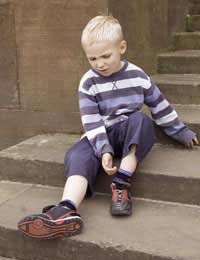'The Naughty Step' as a Discipline Technique

The Naughty Step is a discipline technique, in which parents require children who are behaving inappropriately to sit on a certain step for a designated period of time. Many parents favour the Naughty Step, as it is an easy and effective way to teach children that they have been behaving inappropriately. It also helps children to calm down and decide for themselves how to rectify their behaviour.
Using the Naughty Step
In theory, the Naughty Step is a simple device – a designated step on which children are placed when they are misbehaving. In reality the Naughty Step can be the sight of multiple battles of will. Some children love to manipulate the technique and try to outfox their parents by keeping only one foot or one finger on the step, and others are amenable to remaining on the step however they prefer to cry, kick or scream the entire time. Still, other children will realise that they are not physically bound to the step, and will take to vanishing for small periods when they should be sitting as instructed. To counteract these trials, parents should either make sure that the step is in their line of vision or routinely check on the child while (s)he is seated on the step.The Rationale behind the Naughty Step
The Naughty Step is an effective discipline technique for many reasons. To begin with, it immediately removes a child from the activity or situation which provoked inappropriate behaviour thus, (hopefully) neutralising the behaviour itself. It is also immediate so there is no confusion about why the child is being removed, or which behaviours were inappropriate. Finally, it allows the child the time and space required to calm down and think through their actions. When children are placed on the Naughty Step they should be directed that they can leave when they are ready to discuss the situation. This directs the child’s thoughts towards a resolution of the conflict, and which behaviours would be more appropriate in similar situations in the future.Adapting the Naughty Step
The Naughty Step is not a technique exclusive to families in large houses, and in fact it can be adapted to almost any living space. For example, a Naughty Rug, Naughty Corner or Naughty Stool works just as well. Almost anything can be used in the place of an actual step, though comfortable chairs and beds should be avoided. The Naughty Step can also be adapted to larger areas as the child grows, so that by the time the child reaches 8 or 9 years of age, there is a designated “calming room” or area where they can be sent as needed. Finally, the Naughty Step can also be used in public – even if it means directing your child to sit quietly on a napkin! Often parents are wary of disciplining children in public, but the Naughty Step is so commonplace these days that other parents are likely to applaud its use whenever and wherever misbehaviour occurs.Not every parent uses the Naughty Step, but it is a successful discipline technique for many. The Naughty Step removes a child from the source of trouble, it allows the child the time and space to calm down, and it effectively communicates to the child that their behaviour was inappropriate. The Naughty Step can even be adapted to suit any child or location, making it perfectly portable and effective.
- B.F. Skinner's Behavioural Theory
- The Effects of Punishment on Children
- 'Time Out' as a Discipline Technique
- Discipline Outside The Home
- Disciplining Children
- Disciplining Young Children
- Chores for Children
- Behavioural Disorders in Children
- Common Behavioural Problems in Children
- Reinforcing Good Behaviour
- Rewarding Good Behaviour
- Child Temper Tantrums
- The 'Terrible Twos'


Re: Speech Therapy for Children
Dear Speech Therapy Clinic, I am writing to inquire about speech therapy services for my 3-year-old son. I have noticed that he…
Re: Child Temper Tantrums
I often use my book center for a calm down center. It is not a punishment but a place to take a break and calm down quietly
Re: Mahler's Theory of Development
I'm learning a lot about the end theories .
Re: Child Temper Tantrums
As an assistant director, I get brought kids who the teachers are struggling with to help calm them down. I bring them into my office, we…
Re: Brain Development in Young Children
Hi I have a son. He is 2 and half years old and he is diagnosed with autism. He doesn’t respond to his name and appears…
Re: Child Temper Tantrums
i think once you start to learn the child handling their behavior is easier. it takes time but patience is a virtue!
Re: Erikson's Theory of Psychosocial Development
No, children develop in their own pace for example, a 1-year-old would develop to hold a pencil and another…
Re: Extra Tutoring: How Do I Pay?
i am looking to help out students with private tuition as their parents cant afford it i would like to apply for grants or…
Re: The 'Terrible Twos'
child throws temper tantrum when its cleanup time even when singing the cleanup song, hits my hand and starts pulling the toys back out of the…
Re: Child Temper Tantrums
we work with 5 year olds to 12 year olds.We try to tell the kids what are the basic rules the first day of school.We call them friends from…